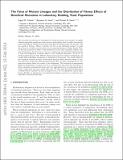| dc.contributor.author | Frenkel, Evgeni | |
| dc.contributor.author | Good, Benjamin Harmar | |
| dc.contributor.author | Desai, Michael Manish | |
| dc.date.accessioned | 2014-11-19T17:00:11Z | |
| dc.date.issued | 2014 | |
| dc.identifier.citation | Frenkel, Evgeni M., Benjamin H. Good, and Michael M. Desai. 2014. The Fates of Mutant Lineages and the Distribution of Fitness Effects of Beneficial Mutations in Laboratory Budding Yeast Populations. Genetics 196, no. 4: 1217–1226. | en_US |
| dc.identifier.issn | 0016-6731 | en_US |
| dc.identifier.issn | 1943-2631 | en_US |
| dc.identifier.uri | http://nrs.harvard.edu/urn-3:HUL.InstRepos:13399409 | |
| dc.description.abstract | The outcomes of evolution are determined by which mutations occur and fix. In rapidly adapting microbial populations, this process is particularly hard to predict because lineages with different beneficial mutations often spread simultaneously and interfere with one another’s fixation. Hence to predict the fate of any individual variant, we must know the rate at which new mutations create competing lineages of higher fitness. Here, we directly measured the effect of this interference on the fates of specific adaptive variants in laboratory Saccharomyces cerevisiae populations and used these measurements to infer the distribution of fitness effects of new beneficial mutations. To do so, we seeded marked lineages with different fitness advantages into replicate populations and tracked their subsequent frequencies for hundreds of generations. Our results illustrate the transition between strongly advantageous lineages that decisively sweep to fixation and more moderately advantageous lineages that are often outcompeted by new mutations arising during the course of the experiment. We developed an approximate likelihood framework to compare our data to simulations and found that the effects of these competing beneficial mutations were best approximated by an exponential distribution, rather than one with a single effect size. We then used this inferred distribution of fitness effects to predict the rate of adaptation in a set of independent control populations. Finally, we discuss how our experimental design can serve as a screen for rare, large-effect beneficial mutations. | en_US |
| dc.description.sponsorship | Organismic and Evolutionary Biology | en_US |
| dc.description.sponsorship | Physics | en_US |
| dc.language.iso | en_US | en_US |
| dc.publisher | Genetics Society of America | en_US |
| dc.relation.isversionof | doi:10.1534/genetics.113.160069 | en_US |
| dc.relation.hasversion | http://arxiv.org/pdf/1402.3304v1.pdf | en_US |
| dash.license | OAP | |
| dc.subject | distribution of fitness effects | en_US |
| dc.subject | clonal interference | en_US |
| dc.subject | beneficial mutations | en_US |
| dc.subject | experimental evolution | en_US |
| dc.subject | Saccharomyces cerevisiae | en_US |
| dc.title | The Fates of Mutant Lineages and the Distribution of Fitness Effects of Beneficial Mutations in Laboratory Budding Yeast Populations | en_US |
| dc.type | Journal Article | en_US |
| dc.description.version | Accepted Manuscript | en_US |
| dc.relation.journal | Genetics | en_US |
| dash.depositing.author | Desai, Michael Manish | |
| dc.date.available | 2014-11-19T17:00:11Z | |
| dc.identifier.doi | 10.1534/genetics.113.160069 | * |
| dash.contributor.affiliated | Good, Benjamin | |
| dash.contributor.affiliated | Frenkel, Evgeni | |
| dash.contributor.affiliated | Desai, Michael | |


